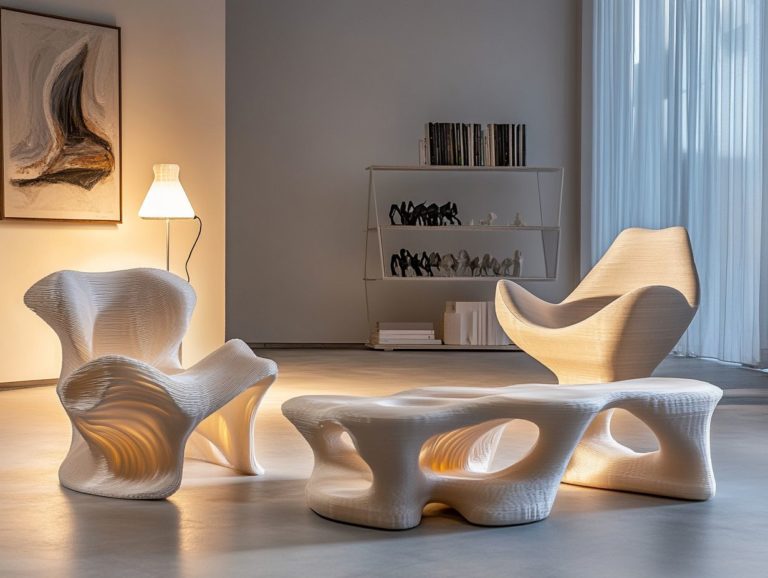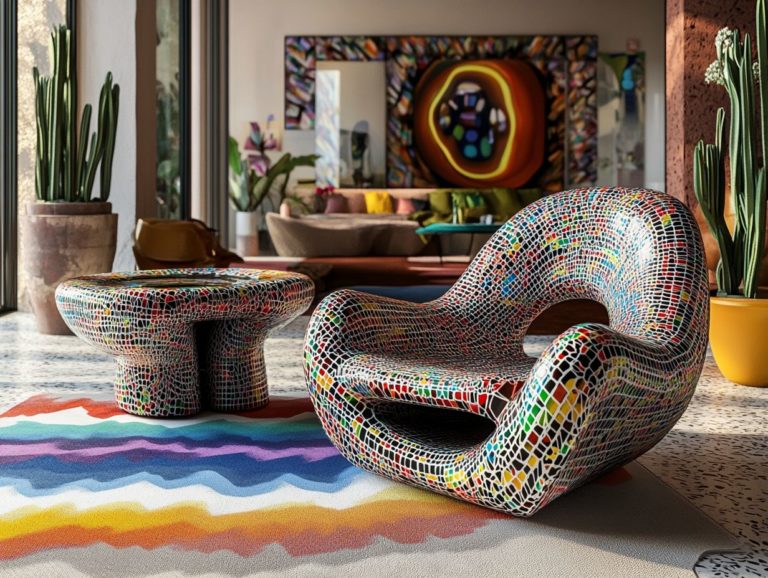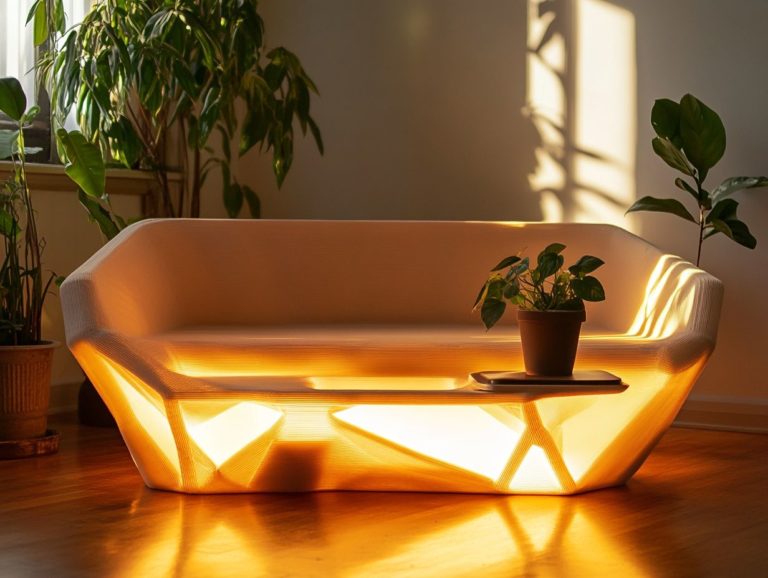How to Choose the Right 3D-Printed Furniture for Your Home
3D printing is revolutionizing your approach to furniture design and production. From sleek chairs to intricate tables, this technology unlocks a world of possibilities, blending cost-effectiveness with breathtaking customization.
As you dive into the realm of 3D-printed furniture, it’s essential to consider several key factors, such as design, materials, and space requirements.
This guide will illuminate the benefits, considerations, and best practices for selecting and maintaining the ideal 3D-printed pieces that will elevate your home.
Contents
- Key Takeaways:
- Benefits of 3D-Printed Furniture
- Factors to Consider Before Choosing 3D-Printed Furniture
- How to Choose the Right 3D-Printed Furniture for Your Home
- Maintaining and Caring for 3D-Printed Furniture
- Frequently Asked Questions
- What is 3D-printed furniture and why should I consider it for my home?
- How can I ensure that the 3D-printed furniture I choose will fit in with my existing decor?
- What materials are commonly used for 3D-printed furniture and which is the most durable?
- How can I be sure that the 3D-printed furniture I choose is safe for my home?
- What factors should I consider when choosing a 3D printing company for my furniture?
- Can I return or exchange 3D-printed furniture if I am not satisfied with it?
Key Takeaways:
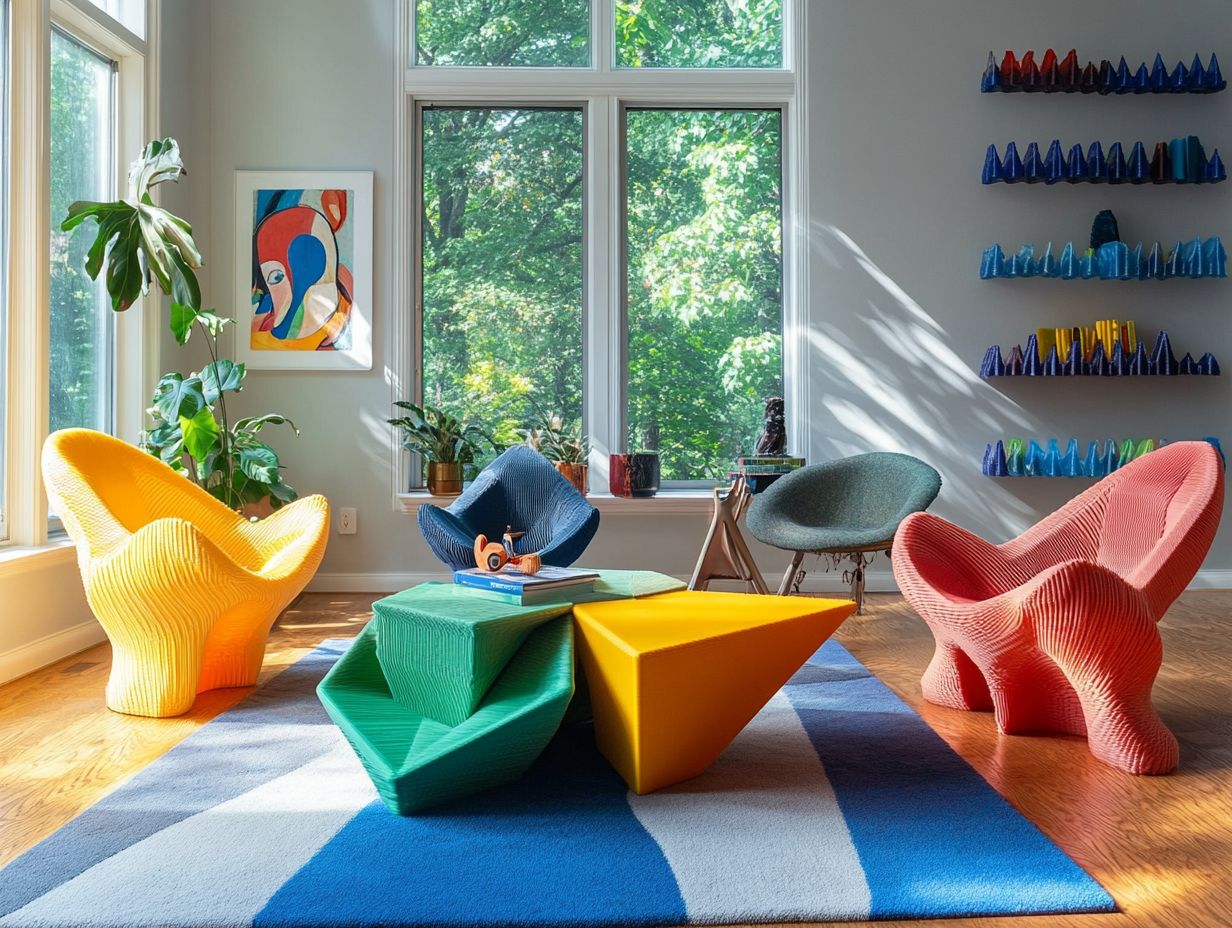
- Consider your design preferences and functional needs when choosing 3D-printed furniture.
- Research and compare options before making a decision, and consult with a professional for expert advice.
- Maintain and care for your 3D-printed furniture by following tips for longevity and cleaning.
What is 3D Printing and How Does it Work?
3D printing is a groundbreaking technology that enables you to create three-dimensional objects by layering materials according to digital designs. This innovative process transforms a computer-aided design (CAD) file into tangible items using a variety of materials, including plastics and biocomposites.
The advancements in 3D printing have unlocked a wealth of applications across industries, from rapid prototyping to custom furniture design, highlighting its remarkable versatility.
You can explore several methodologies within this technology, such as:
- Fused Deposition Modeling (FDM)
- Stereolithography (SLA)
- Selective Laser Sintering (SLS)
Each provides distinct advantages tailored to specific applications.
In the world of furniture design, companies like The New Raw are pioneering efforts by incorporating sustainable materials into their 3D printing processes. This results in customizable and eco-friendly products.
By using bioplastics and recycled materials, designers are not only creating stunning pieces but are also tackling urgent environmental challenges.
Zaha Hadid Architects exemplify the application of 3D printing in architectural components, demonstrating how this technology can push the boundaries of traditional design.
With limitless possibilities on the horizon, 3D printing is reshaping not only design but entire manufacturing ecosystems.
Benefits of 3D-Printed Furniture
The advantages of 3D-printed furniture go well beyond mere visual appeal. They embody sustainability, customization, and innovation.
This positions them as an exceptional choice for today s home decor.
By harnessing sustainable materials such as PLA and recycled components, 3D-printed furniture significantly reduces production waste and diminishes the carbon footprint.
The unique nature of these pieces allows designers to create distinct structures tailored to your preferences. This reinforces the growing trend toward eco-conscious design in contemporary interiors.
Explore the world of 3D-printed furniture today and transform your home with stunning designs that reflect your style and values!
Cost-Effectiveness and Customization
Imagine designing furniture that perfectly matches your style and budget! 3D printing offers great customization choices and cost savings.
By using computer technology, you can reduce waste and lower production costs. You can customize dimensions, colors, and materials to fit your needs.
This innovation allows you to invest in unique furniture without the high prices usually associated with custom pieces. For example, adjust the height or finish of a coffee table to match your living room perfectly.
Embrace these trends to find artisans offering stunning modular designs that redefine craftsmanship.
Factors to Consider Before Choosing 3D-Printed Furniture
Before you buy 3D-printed furniture, consider key factors like design, functionality, materials, and durability, as well as how to incorporate 3D-printed furniture in small spaces.
Your choice should reflect your style and ensure comfort for daily use.
The materials you select, from hybrid options to biocomposites, affect the product s strength. Weigh these elements carefully for a worthwhile investment in your home.
Design and Functionality

The balance of design and functionality is crucial. Innovative techniques allow you to create furniture that looks great and is comfortable for daily life.
By merging artistic expression with practical needs, you can create unique pieces that enhance your home decor.
This balance considers your physical needs and the emotional connection these pieces create. Comfortable features, like lumbar support, are becoming standard in modern designs.
Collaborations between designers and tech firms lead to exciting projects, like the Flavoured Chair, showing how creativity and function can work together. Explore how these innovations can transform your living space!
Materials and Durability
The choice of materials in 3D printing is pivotal for determining the durability and longevity of the furniture you produce. Advanced options provide both strength and sustainability.
Beyond traditional plastics, innovative materials such as wood-filled filaments and metal-infused polymers are making a significant impact in the industry. These alternatives enhance both the aesthetic appeal and the stability of your furniture.
For example, biocomposites are crafted from natural fibers and resins. They offer an eco-friendly option that reduces reliance on fossil fuels and aligns with modern sustainability goals.
Incorporating recycled materials like PLA, which stands for polylactic acid and is biodegradable, minimizes waste and champions a circular economy, where materials are reused and recycled. This strategy nurtures both functional excellence and ecological mindfulness, setting the stage for future advancements in furniture technology.
Size and Space Considerations
In the realm of 3D-printed furniture, size and space considerations are crucial. They significantly influence how seamlessly your pieces integrate into contemporary home settings. For those looking to make eco-friendly choices, exploring the best 3D-printed furniture for eco-conscious living can be a game-changer.
Careful planning regarding dimensions and layout ensures that each item enhances your existing decor and meets functional needs without sacrificing aesthetic appeal. This thoughtful approach is particularly effective in maximizing the usability of smaller living spaces.
To effectively assess your available space, start by measuring your rooms meticulously. Pay attention to factors such as traffic flow and natural light.
Taking stock of existing elements like doors, windows, and electrical outlets will provide valuable insights into the optimal positioning for your new pieces. Harmonious integration of furniture involves selecting items that fit well and resonate with a cohesive color palette and style.
Embracing modular designs in 3D-printed furniture offers the flexibility to adapt and rearrange as your needs evolve. By prioritizing size and space, you can transform your home into a beautifully functional environment tailored to your lifestyle.
How to Choose the Right 3D-Printed Furniture for Your Home
Selecting the ideal 3D-printed furniture for your home is an exciting journey that involves understanding how to style your space with 3D-printed furniture while thoughtfully considering your unique needs alongside the distinctive features of available pieces.
Start by evaluating your personal preferences and lifestyle requirements. Ensure that every item resonates with your aesthetic vision and fulfills your functional necessities.
Seeking professional consultation can elevate your decision-making process, offering valuable insights into the latest furniture trends and design innovations perfectly suited to your space. Act now to find the perfect pieces that will elevate your space and reflect your style!
Assessing Your Needs and Preferences
The first step in selecting 3D-printed furniture is to thoroughly assess your needs and preferences. For guidance on this, check out how to decorate with 3D-printed furniture. This lays the groundwork for informed decisions that elevate your home improvement projects.
By reflecting on your lifestyle, aesthetic values, and functional requirements, you’ll be able to narrow down your choices to pieces that resonate with your vision for contemporary home decor. This proactive approach simplifies the selection process and ensures that each piece enhances the value of your space.
Understanding how your daily routines and individual tastes shape your environment is crucial. Consider factors such as the available space, intended use of each room, and existing color palettes.
To effectively evaluate your needs, you might create a checklist that prioritizes functionality like durability for a bustling family or stylish appeal for a serene study. Seeking inspiration from design magazines or online platforms can ignite your creativity.
This careful consideration of lifestyle and design inspirations not only guides your decisions but also fosters a harmonious living environment.
Researching and Comparing Options

Once you’ve defined your needs, the next step is to research and compare various 3D-printed furniture options. Digital platforms and designer collaborations provide a wealth of information about styles, materials, and functionalities, including the best practices for designing 3D-printed furniture.
This exploration broadens your understanding of furniture trends. It enables you to make informed comparisons, leading to better purchasing decisions.
Utilize online resources such as design websites, social media platforms, and virtual showrooms to discover innovative pieces and emerging designers. Engaging with user reviews and expert evaluations helps you understand product durability and look.
Keep an eye on eco-friendly practices to see how materials influence design and manufacturing processes in 3D-printed furniture.
Consulting with a Professional
Working with a professional can transform your furniture selection into an exciting adventure! Experts provide insights into design techniques and available solutions.
These professionals guide you on the latest innovations and material properties, ensuring your choices meet aesthetic desires and functional needs.
By leveraging a designer’s expertise, you can navigate contemporary trends. This ensures your selections resonate with your style while aligning with sustainable practices.
Designers help overcome design problems, whether it s optimizing space or selecting eco-friendly materials. Their insights show how each piece adds to your environment while using innovative technology.
Using professional knowledge enriches your shopping experience. You ll feel confident your 3D-printed furniture will not only look great but fit your lifestyle!
Maintaining and Caring for 3D-Printed Furniture
Caring for your 3D-printed furniture is vital for its longevity and appearance. A thoughtful approach to cleaning and upkeep is key.
Understanding the material properties of your pieces is essential, as different materials require unique cleaning techniques.
By embracing best practices, you can keep your 3D-printed creations looking good and strong for years to come.
Tips for Longevity and Cleaning
To ensure the longevity of your 3D-printed furniture, adopt effective cleaning techniques that cater to the specific material properties of each piece. Regular dusting and gentle cleaning methods help prevent dirt and grime from accumulating, safeguarding the finish and integrity of your furniture.
Understanding the unique care requirements of materials like PLA (a biodegradable plastic) and hybrid composites can help you maintain their aesthetic appeal while extending their lifespan.
Adapting your maintenance routines to the specific characteristics of each material is beneficial. For example, PLA requires careful handling to avoid exposure to extreme heat, while composite materials may need a different approach to ensure durability.
Regularly check for scratches or wear. Periodic reapplications of protective coatings enhance both the appearance and usability of your furniture. Act now to protect your unique pieces and enjoy them for years while preserving their original charm and functionality.
Frequently Asked Questions
What is 3D-printed furniture and why should I consider it for my home?
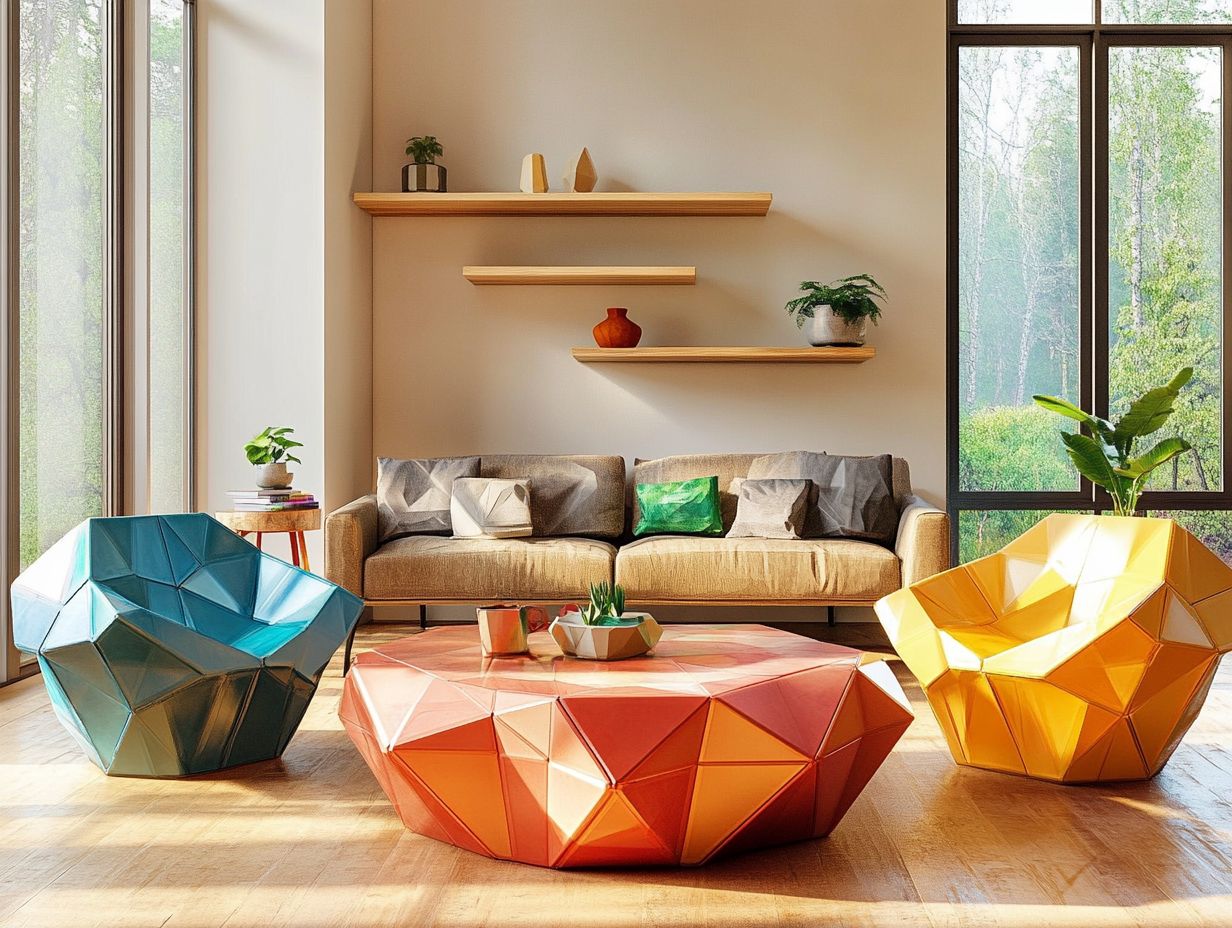
3D-printed furniture uses innovative technology for customizable designs. It s a great choice for those wanting unique and personalized pieces.
How can I ensure that the 3D-printed furniture I choose will fit in with my existing decor?
When selecting 3D-printed furniture, measure your space and consider the design and color of your current decor. You can learn more about this in the article on how to incorporate 3D-printed furniture in your decor. Many companies offer customization options to help you find a design that complements your existing pieces.
What materials are commonly used for 3D-printed furniture and which is the most durable?
Common materials for 3D-printed furniture include PLA and ABS plastics. While PLA is more environmentally friendly, ABS is known for its durability. The best choice depends on your furniture’s design and intended use.
How can I be sure that the 3D-printed furniture I choose is safe for my home?
When buying 3D-printed furniture, ensure it meets safety standards. For a comprehensive list of options, check out the best 3D-printed furniture stores online. Look for non-toxic, environmentally friendly materials and follow assembly instructions for stability and safety.
What factors should I consider when choosing a 3D printing company for my furniture?
Consider the company’s reputation, customer reviews, and customization options. It’s also important to ask about their production process and quality control measures for a high-quality product.
Can I return or exchange 3D-printed furniture if I am not satisfied with it?
Most 3D printing companies have return or exchange policies. Check with the specific company before purchasing and read their policies to avoid potential issues.

